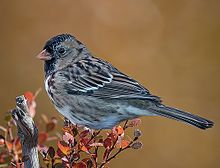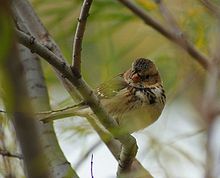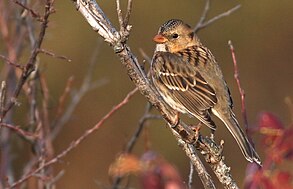Harris's sparrow
| Harris's sparrow Temporal range:
| |
|---|---|

| |
| Harris's sparrow, Ennadai Lake, Nunavut | |
| Scientific classification | |
| Domain: | Eukaryota |
| Kingdom: | Animalia |
| Phylum: | Chordata |
| Class: | Aves |
| Order: | Passeriformes |
| Family: | Passerellidae |
| Genus: | Zonotrichia |
| Species: | Z. querula
|
| Binomial name | |
| Zonotrichia querula (Nuttall, 1840)
| |

| |
| Range of Z. querula Breeding Migration Nonbreeding
| |

Harris's sparrow (Zonotrichia querula) is a large
Description
This species is the largest of the sparrows in the family
This is a very distinctive looking species. Breeding plumage birds have conspicuous pink bills and black on the crown, face, throat and upper breast, contrasting with grey on the sides of the head and neck. The back is brown, overlaid with heavy black streaking. There are two white wing bars. Breeding birds have white lower underparts with some black mottling on flanks. Non-breeding adults are more
The song of Harris's sparrow is usually delivered from a high perch. The song consists of a series of one or more clear high wavering whistles followed by another series in higher or lower pitch. They have also been known to call out a strong, metallic chink, as well as some variable musical twittering.
Habitat
Harris's sparrow breeds in stunted
Behaviour

Migration
Spring migration commences around late February with birds arriving on breeding grounds by May. Sparrows arrive on their wintering grounds as early as late October, though mostly during November and early December. Records from Banff National Park suggest Harris's sparrows use mountain valleys as migration routes.[4] Apparently, fall migration is less strict than spring migration as Harris's sparrows regularly wander about prairie provinces in Canada until harsh weather forces them south.[5]
Feeding ecology
Harris's sparrow generally feeds on the ground, scratching vigorously in the leaves and soil for food. Observed foraging during nesting was 85% ground-gleaning. The diet of wintering Harris's sparrow is less well-known and has not been quantitatively studied.
Sociality
Males of this species often group together to sing at dusk. In winter flocks, Harris's sparrows maintain linear dominance hierarchies that determine access to food and roost sites. The most dominant birds are the oldest males which usually also have the largest bibs. "Jump fights" between males occasionally occur, consisting of birds facing off, then leaping at each other, pecking, clawing and beating each other with wings. Testosterone alone does not affect the dominance status of winter birds. If first winter birds have their feathers dyed black, creating an artificially large bib, they rise in the dominance hierarchy past females and other young males.[8] It is usually found in flocks up to several dozen in winter, individuals regularly wandering outside of the "normal" range and turning up in flocks of other sparrow species.
Reproduction
Breeding pairs establish a territory of about 2 ha (4.9 acres).
Longevity and mortality
Harris's sparrow has lived for up to 11 years and 8 months in the wild. Predators on the nest can including varied terrestrial mammals, including Arctic ground squirrels (Spermophilus parryii) and stoats (Mustela erminea).[13] Harris's sparrows provide an easy target for these predators due to the location of their nests on the ground. Canada jays (Perisoreus canadensis), northern shrikes (Lanius excubitor) and merlins (Falco columbarius) can be a serious predators at the nest (including both nestlings and adults).[6] Shrikes, sharp-shinned hawks (Accipiter striatus) and great horned owls (Bubo virginianus) are known predators of wintering Harris's sparrows.[5] As an anti-predator adaptation, Harris's sparrows fly up into trees when startled by other animals, usually issuing an alarm call in the process (weenk). They duck down to the ground when threatened by other birds. They also produce alarm calls when threatened to alert others.[6]
Conservation status
This species is classified as being of
References
- ^ . Retrieved 11 November 2021.
- ^ Timoney, K. P., G. H. La Roi, S. C. Zoltai, and A. L. Robinson. 1992. The high subarctic forest-tundra of northwestern Canada: position, width, and vegetation gradients in relation to climate. Arctic 45:1-9.
- ^ Swenk, M. H. and O. A. Stevens. 1929. The Harris's Sparrow and the study of it by trapping. Wilson Bulletin 41:129-177.
- ^ Salt, Jim R. 1998. Some bird records from Jasper National Park. Alberta Naturalist 28(4):73-74.
- ^ a b Baumgartner, A. M. 1968. Harris's Sparrow. Pages 1249-1273 in Life histories of North American cardinals, grosbeaks, buntings, towhees, finches, sparrows, and their allies, part 3. Vol. 237 (Austin, Jr., O. L., Ed.) U.S. National Museum Bulletin
- ^ a b c d e Norment, C. J. 1992a. The comparative breeding ecology of the Harris's Sparrow (Zonotrichia querula) and White-crowned Sparrow (Zonotrichia leucophrys) in the Northwest Territories, Canada. Phd Thesis. University of Kansas, Lawrence.
- ^ a b Semple, J. B. and G. M. Sutton. 1932. Nesting of Harris's Sparrow Zonotrichia querula at Churchill, Manitoba. Auk 49:166-183.
- ^ Rohwer, S. and J. C. Wingfield. 1981. A field study of social dominance, plasma levels of luteinizing hormone and steroid hormones in wintering Harris's Sparrows. Zeitschrift für Tierpsychologie 57(2):173-183.
- ^ Norment, C. J. & S. A. Shackleton. 1993. "Harris' Sparrow (Zonotrichia querula)". In Birds of North America, No. 64 (A. Poole & F. Gill, eds.) Philadelphia: The Academy of Natural Sciences; Washington, DC: The American Ornithologists' Union.
- ^ Rees, W. R. 1973. Comparative ecology of three sympatric species of Zonotrichia PhD Thesis. University of Toronto, Toronto.
- ^ a b Norment, C. 2003. Patterns of Nestling feeding in Harris’s Sparrows, Zonorichia querula and White-crowned Sparrows, Z. leucophyrs, in the Northwest Territories, Canada. Canadian Field-Naturalist, 117: 203-208.
- ^ a b Cornell Lab of Ornithology
- ^ Norment, C. J. 1992b. Comparative breeding biology of Harris's Sparrows (Zonotrichia querula) and Gambel's White-crowned Sparrows (Zonotrichia leucophrys gambelii) in the Northwest Territories, Canada. Condor 94:955-975.
- ^ "Audubon Watchlist - Harris's Sparrow". Audubon. Archived from the original on 2013-05-11. Retrieved 2013-06-28.
- ^ Kasischke, E. S., Christensen Jr, N. L., & Stocks, B. J. (1995). Fire, global warming, and the carbon balance of boreal forests. Ecological Applications, 437-451.
- ^ Goulden, M. L., Wofsy, S. C., Harden, J. W., Trumbore, S. E., Crill, P. M., Gower, S. T., ... & Munger, J. W. (1998). Sensitivity of boreal forest carbon balance to soil thaw. Science, 279(5348), 214-217.
- Sparrows and Buntings: A Guide to the Sparrows and Buntings of North America and the World by Clive Byers & Urban Olsson. Houghton Mifflin (1995). ISBN 978-0395738733.
Further reading
- Norment, C. J. Ph.D. (2007). Return to Warden's Grove: Science, desire, and the lives of sparrows. Iowa City, IA: University of Iowa Press.
- Norment, C. J. and S. A. Shackleton. 1993. Harris’s Sparrow (Zonotrichia querula). In The Birds of North America, No. 64 (A. Poole and F. Gill, Eds.). Philadelphia: The Academy of Natural Sciences; Washington, D.C.: The American Ornithologists’ Union.
External links
- Harris's sparrow species account - Cornell Lab of Ornithology
- Harris's sparrow - Zonotrichia querula - USGS Patuxent Bird Identification InfoCenter
- Harris's sparrow photo gallery VIREO

